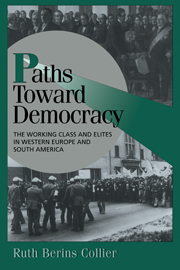Book contents
- Frontmatter
- Contents
- List of Figures and Tables
- Acknowledgments
- 1 Introduction: Elite Conquest or Working-Class Triumph?
- 2 Elite-Led Reform in Early Democratization
- 3 Political Calculations and Socialist Parties
- 4 Labor Action in Recent Democratization
- 5 Comparing the Patterns: The Working Class and Democratization
- Bibliography
- Index
3 - Political Calculations and Socialist Parties
Published online by Cambridge University Press: 05 June 2012
- Frontmatter
- Contents
- List of Figures and Tables
- Acknowledgments
- 1 Introduction: Elite Conquest or Working-Class Triumph?
- 2 Elite-Led Reform in Early Democratization
- 3 Political Calculations and Socialist Parties
- 4 Labor Action in Recent Democratization
- 5 Comparing the Patterns: The Working Class and Democratization
- Bibliography
- Index
Summary
The advent of social democracy brought about a third pattern, Joint Projects, in which the working class most clearly played an important role. Although these are the cases most often described as working-class democratization, a number of features in this depiction lack sufficient recognition. This pattern combines projects from above and from below in class terms, in that democratic reform was the outcome of the strategies of the working class as well as other classes. Also these cases primarily entail incumbent projects – that is, all the major actors, including the working class by the time it got involved, had the political status of an “in” group. A final feature is that both arenas of action came into play – the deliberation/negotiation arena and the protest arena of mass mobilization. In the pattern of Support Mobilization, analyzed in the preceding chapter, democratic reform was pursued by strategizing elites or political leaders to build an electoral support base. What has often been overlooked is the extent to which this strategic dynamic was also part of the cases in the Joint Projects pattern – and the fact that parliamentary labor-based parties were players in this game of competitive struggles among parties.
JOINT PROJECTS
The temporal and geographical clustering of the cases characterized by Joint Projects is striking and reflects important processes of economic development, political strategizing, and diffusion of political innovations. We return to this issue in Chapter 5.
- Type
- Chapter
- Information
- Paths toward DemocracyThe Working Class and Elites in Western Europe and South America, pp. 77 - 109Publisher: Cambridge University PressPrint publication year: 1999



